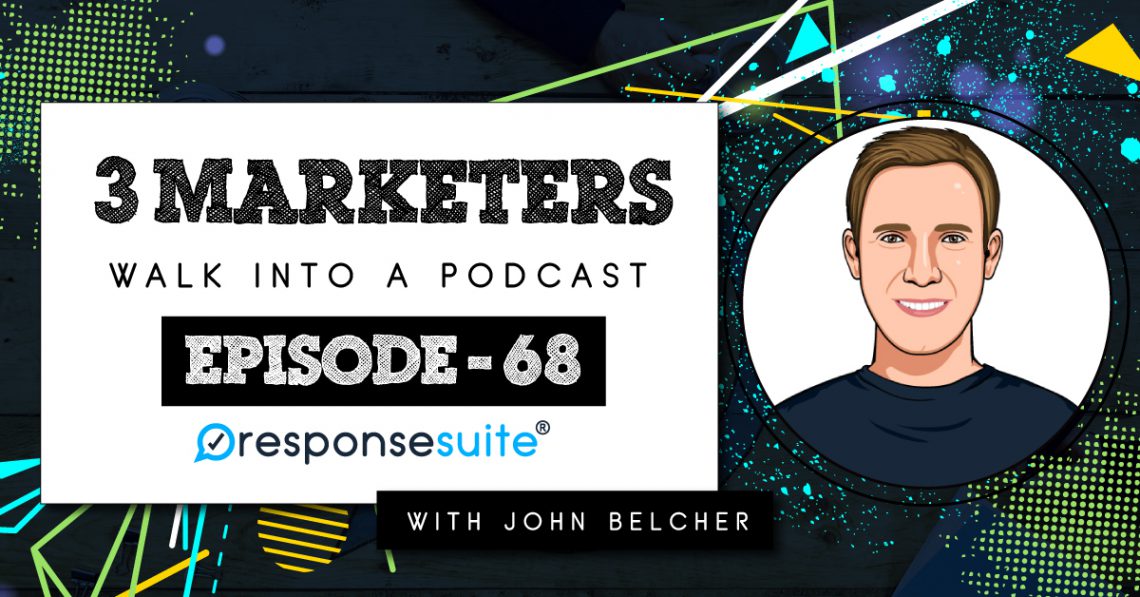Stats, numbers, and calculating conversions can be confusing. So, how do you make sense of it all, especially across multiple platforms?
John Belcher is here to dive into the best tracking methods, including the brilliant Northstar concept!
Find out how to track your conversions, drive more sales, and what questions you should be asking along the way…
Subscribe now on your favourite podcast player:

We’ve hit that ceiling where we can’t get any further from one platform, what do we do next?
- Whenever you’re doing paid traffic, you typically run into a plateau. You hit this artificial ceiling, your return starts to go down after increasing the amount of money spent.
- You have to start by looking at the numbers you have to get your tracking dialed in.
- Tracker is the number one thing when you start to scale up. It’s the highest ROI thing you have.
- Breakthrough barriers using traffic networks.
How do we plow through that ceiling? How do we actually scale to that next level? How do we do that without losing our ROI? What do we do about discrepancies?
- Tracking platforms are biased. They take credit for absolutely everything, so you can continue to spend money with them.
- Tracking is all client-side. Conversions can be dropped by a browser that is not allowing cookies if you’re using client-side data.
- Post back extra conversions, if not smart bidding technology will be off because enough sales aren’t being sent back.
- Conversions can get double counted or lost.
- The problem with analytics is it's not the actual number your seeing with CRM.
- Know when it’s time to scale or fix the problem.
Is there something we have to put in before?
- View through conversions, where two platforms are taking credit for it. This is where the bias starts to come in.
- You need to get a tracking system in place called the Northstar, it’s never going to be 100% accurate. Be comfortable with 85%, directional accuracy.
- When there are directional ratios, that’s when we feel comfortable continuing to scale up that traffic source.
So this Northstar piece, is that a piece of technology or a number you’re just looking for?
- It’s a technology that identifies what the analytics are.
- The first thing is to commit to this source, base all decisions off it, trust it in order to move forward.
- Wicked Reports helps for decisions over time, but does not do real-time reporting. To make sure things are functioning, google analytics is good for day to day use.
Does it depend on what process of building up your funnel?
- There are three metrics. ROI is what everything is based on, so look at the cost per acquisition.
- Look at funnels, metrics that exist inside funnels start with ads.
- Metrics can hold up the ability to scale more as budget increases.
- The advertorial explains problems and introduces a solution.
- You can’t look at all of them at the same time, so start at the top and work your way down
- To optimize campaigns, start with ad click-thru rates and then CPA and then find the best combination.
- Iterate your creative, start by working on one advertorial. Understand different parts in the funnel and then break it down into different steps.
How do we track all the way through the funnel?
- Which sources are driving the most leads?
- Use higher-level analytics tools. I recommend Wicked reports.
- Have monthly, weekly audits to find out which ads are driving sales.
Which turn into sales?
- Optimize each step of the funnel to scale up.
- When talking about scaling up, there are two; those focused on average order value or those focused on lifetime value. Lifetime value can out scale ROI because of focus on the big picture.
- When focused on profit right this second, ad costs go up, there is more competition entering the market, and profits dwindle.
- Where is the long term money at? Invest in analytics to turn into a lifetime value company.
- LTV companies can outspend you every time. They look at last-click attribution.
- People may not be interested the first time around if your not looking at the long haul that’s when you get stuck at that ceiling.
- See how our spend looks across our halo, not directly tracked.
- Wicked Reports tracks from first-time interaction. It tracks all people that click through on content over time. Gives insights that may have turned into missed opportunities overwise.
- Look at how to drive as many sales as possible using directional accuracy.
How often should we be looking at these?
- Usually weekly to get really good data.
- Become really good at paid traffic when you are too busy and you just let the data run.
- Micro conversions are the way to understand ad click-through rate, advertorial, etc.
- You have to constantly be iterating creative to keep delivery up, so focus on the funnel. The creative stacks that happen before you get to the page and before you get to a sale.
- A daily goal should be to look at the ratio, how to improve metrics on the front end so the back end can take care of itself.
So is it usually a front end thing?
- Once something is working.
- Win with creative on the front end, continuing to test things, iterate, optimize.
- If the weekly test ad beats the control, this becomes the new control. Next step is advertorial, iterate to see if it beats that control, and move on to the next step.
- Always try to beat control. Singular sale message always trying to improve. You can’t continue to improve your creative and numbers on the front end if you don’t have tracking in place.
Do we take the best performer and it’s fine if it's performing really well or start from scratch?
- Convert cold clicks.
- One ad can do a lot more selling than another ad can. You cannot plug and play an ad from one place to another. Ad units are all different.
- Once you found an angle that works to convert people, now translate things.
- If the ad unit is doing a lot less selling, so the landing page or advertorial has to do a lot more selling. It's responsible for delivering that sales message. Very different platform, very different creative.
- Translate your message from one platform to another if you want to be able to scale across them.
At what point is it worth saying just screw it?
- If enough margin is coming through in company and you're confident with who you're with.
- Never a bad time to enlist help. Find experienced people that help you, which is the highest ROI you can do.
- Train people who can repair the damages that other agencies have done.
- Ask a lot of questions before handing that check over.
How can we begin to figure out what those questions are going to be?
- You cannot buy a certification.
- The only stamp of approval is if they have gone through my training, can prove results, and go through the most difficult test constructed for as buying.
What’s a starter question?
- Explain the in-depth process you use to get people from where we are to where we want to be.
- Professionals should have no problem talking about things. Ask about the process, if they have a detailed answer and showcase studies of how these things have taken place, and people are willing to speak on their behalf you can work with them confidently. If these things aren’t true, there’s a red flag.


A book that you would recommend…
Wooden on Leadership by John Wooden
What is your top success habit?
Just started with a trainer to track meals and workouts, it’s helped my energy level.
Who do you look up to?
Brian Garvin
What are your favourite apps right now?
Wicked Reports
Here’s the big one… who do you like more, Rob or Kennedy?
Kennedy for the singing which was amazing.
Finally, where can folks go to find out more about you?
You can find out more over at adskills.com





Leave a Comment